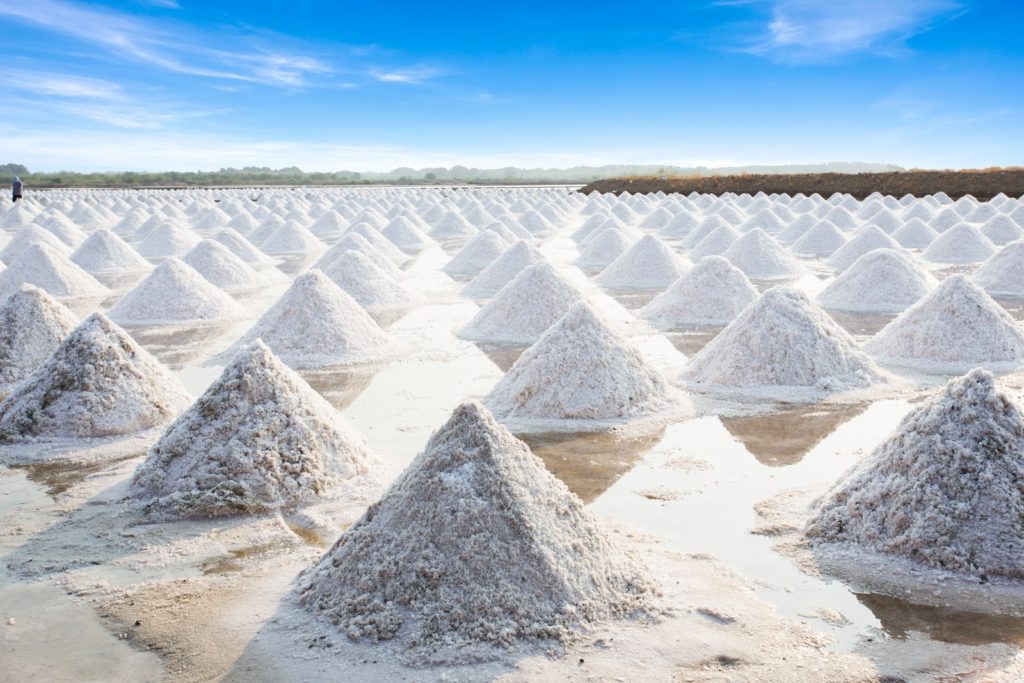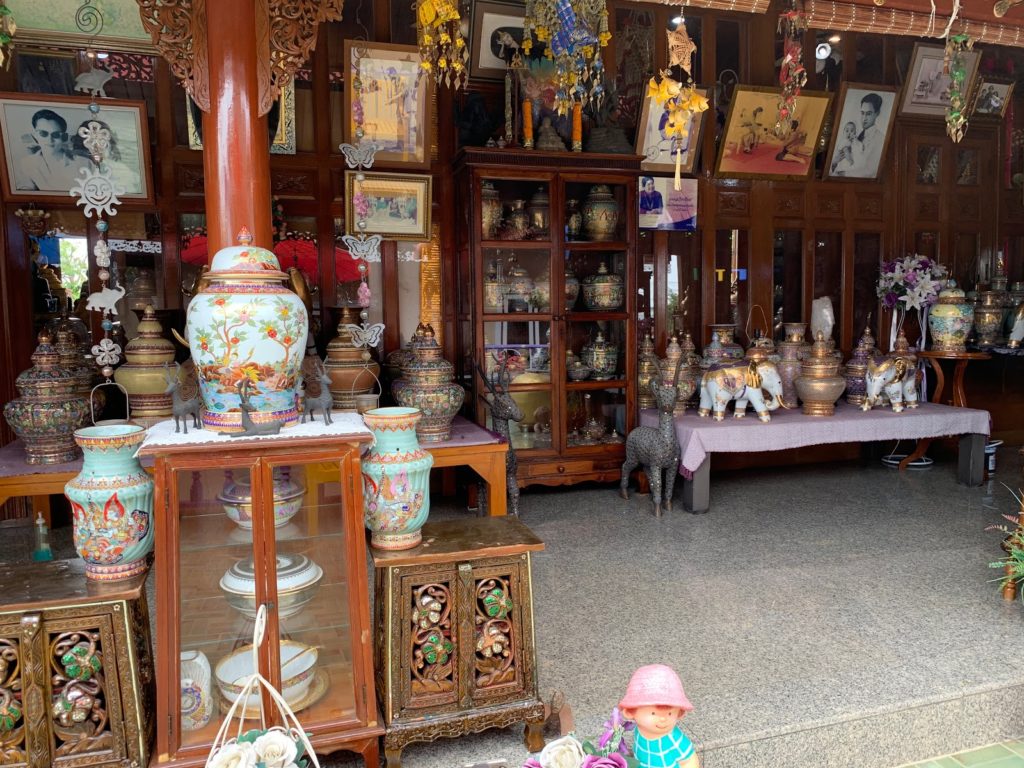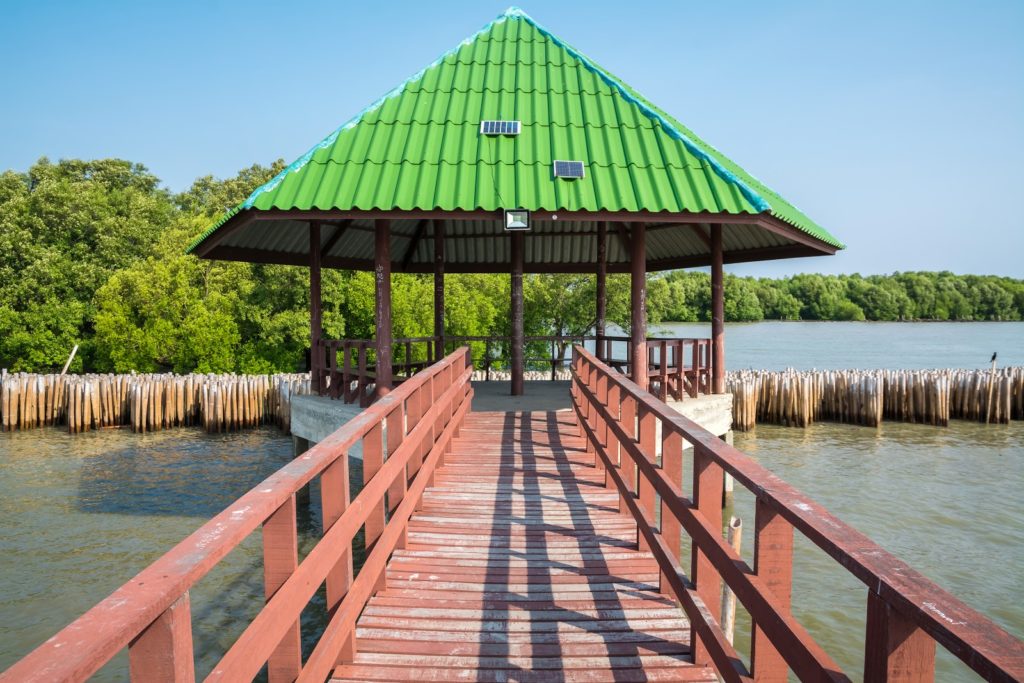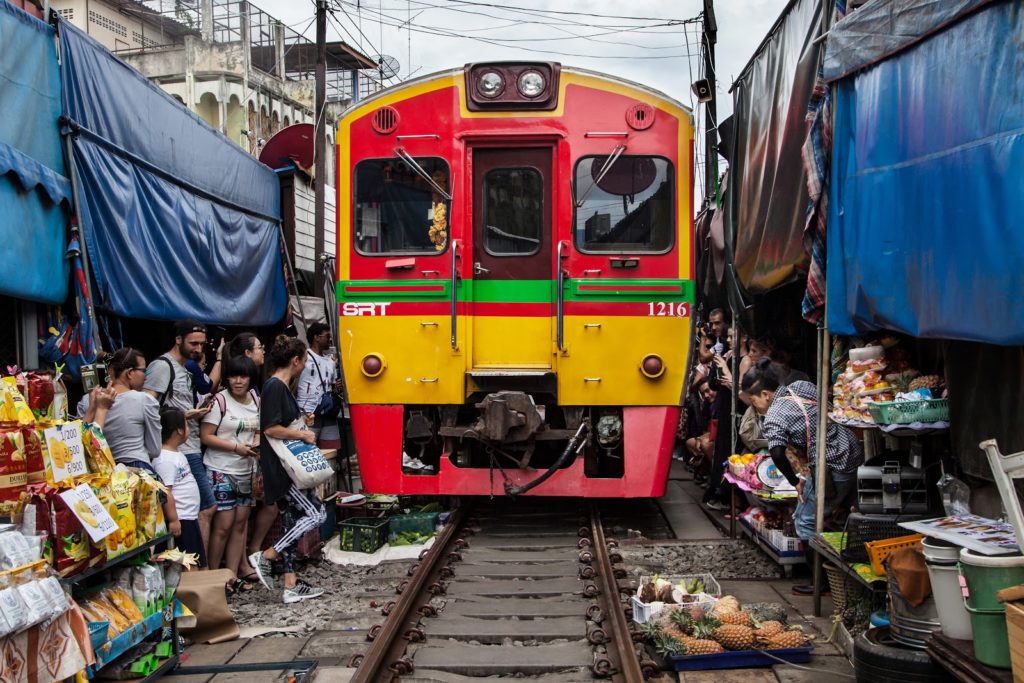The location of these provinces is where the inland waterways and rivers throw themselves into the Gulf of Thailand, leaving plenty of land for farmers to work on their orchards and farms.
The rustic beauty of Thailand’s countryside may be receding, but it hasn’t entirely vanished. About 100 kilometers Southwest of Bangkok, you can embrace mother nature and delve into the local way of life in two small coastal provinces: Samut Songkhram and Samut Sakhon.
Samut Songkhram offers a quick rural retreat and promising local experiences thanks to old riverside communities and networks of canals, coconut plantations, tropical gardens, floating markets, unique arts and crafts, scenic seaside, and sensational food.
Samut Sakhon is often overlooked in favor of its more flaunting neighboring provinces. With a long list of undiscovered charms, the quiet town offers small and quaint fishing villages, local restaurants, and landmarks along its shoreline, tidal causeway, and saltmarsh. From spectacular views to the estuary with endless sandbars to the artisan community, Samut Sakhon is a perfect place to escape the busy crowds of other provinces.

12 Things to Do In Samut Sakhon & Samut Songkhram
1. Spectacular Salt Farms in Samut Sakhon
Samut Sakhon is one of the leading provinces for sea salt farming in Thailand. A visit to some salt farms at the right time of day allows you to experience a breathtaking view when the vast and shimmering expanse of salt sparkles when day breaks. The landscape becomes more magical at sunset, as the mounds of salt set against the red and orange sky. The serene atmosphere reflects the harmonious cohabitation of humans and nature.
The best time to visit is from January to April (summer in Thailand) and from November to December (winter in Thailand). You might catch the sight of salt farmers working in the fields at dawn and late in the evening. Making sea salt is less complicated than pumping seawater into large square fields and leaving it to the sun to dry out the water. However, salt harvesting is phenomenal, and it’s a great photo opportunity.
In Samut Sakhon, salt is harvested by hand like hundreds of years before. The heat of the sun evaporates the water from seawater in the salt fields, which is harmful to the health of salt farmers. To avoid heatstroke, salt farmers tend the fields from 6am to 9am and again late in the afternoon. To harvest salt, the farmers would pile the dry salt into the shape of the small white hill before shoveling it into wicker baskets. With two baskets per carrying pole, farmers would carry the salt to the dry storeroom.

2. Mastering Pottery at Don Kai Dee Benjarong Porcelain Village in Samut Sakhon
Pottery has re-emerged as a popular hobby thanks to the Thai artisan community of Don Kai Dee, being inheritors of classic Chinese porcelain craft. Compared to the pure white and blue color of famous Ming-style porcelain, Thai Benjarong porcelain ware, meaning “five colors,” is colorful with black, red, white, green, and yellow. Flower motifs and sometimes Buddhist art adorn the traditional Thai porcelain ware, which is popular among the smaller group of wealthy families and aristocracy. The revival of painting Thai Benjarong porcelain is thanks to a group of women in Don Kai Dee. Laid off from a ceramic factory in the 1980s, the women of Don Kai Dee took Benjarong porcelain art and trade to the next level with stylish and contemporary designs.
Three-day and one-day courses instructed by porcelain artists are available for visitors who would like to get their hands dirty creating Benjarong porcelain. A longer porcelain course is also available with homestays and basic accommodations, making Don Kai Dee perfect for an artistic retreat. For those who prefer not to get their hands dirty, the village is still worth going for a day trip. Along the small alleys of Don Kai Dee, the visitors will find porcelain wares in different shapes, sizes, and designs worth buying.
Don Kai Dee Benjarong Village, Krathum Baen, Samut Sakhon about 45 minutes from Bangkok
Hours: 8am-6pm
Getting There
To Don Kai Dee, trains (10 Baht/one hour) leave Bangkok’s Wong Wian Yai railway station daily for the Maha Chai railway station in Samut Sakhon. From there, Don Kai Dee is about 15 minutes by tuk-tuk. It is recommended to have a private tour with a driver to minimize any hassle and maximize your comfort.

3. Scenic Stroll & Dining at Red Boardwalk Bridge at Samut Sakhon
Tucked away in the southern tip of Moo Baan Pramong (Fishing Village), Red Boardwalk Bridge is an ideal dining stop during a scenic coastal drive. The red bridge, stretching through the marshes against the blue sky, is charming. On weekends, a horde of day-trippers would visit, wishing to enjoy a scenic stroll, open space, clean air, and dramatic sunset. For the best chance of spotting dolphins, visit the Red Boardwalk Bridge between November and January when they treat themselves with warm seawater in the winter. Bryde’s whales could also be found along the peaceful shoreline, and visitors could book a whale-watching trip with one of the local boats. For hungry travelers and seafood enthusiasts, there are many local restaurants – including Krua Baan Pramong Seafood Restaurant; +66 98 589 2550 – serving deep-fried red snapper with a sensational sauce and different choices of seafood soup.
Getting There
Red Boardwalk Bridge is 16 kilometers from the Maha Chai railway station.
4. Sweet Nostalgia at Amphawa Floating Market in Samut Songkhram
Canals, boat rides, wooden buildings, atmospheric cafes, and quaint waterborne traffic is what makes Amphawa Floating Market unique and famous. On weekends, visitors drive to the floating market for a hefty dose of sweet nostalgia. Everything from tropical fruits like mangosteen, rambutan, coconut, and some local produce is sold and hawked on small wooden boats floating along the canals. Marketplace vendors usually grill large prawns, fresh scallops, and crabs, as well as noodles, ice cream, and coffee, which are served from small boats. Unlike Damnoen Saduak Floating Market, you don’t have to hop on the boats and paddle through the canal for your mango and sticky rice – but it doesn’t mean less adventure. After lunch, get on a long-tailed boat to explore the canals crisscrossing the communities and orchards. You’ll forget the slow pace and gentle nature of the merchant boat when you hop on the long-tailed boat. With its powerful engine, the long-tailed boat can dart in and out a canal at fast speeds. For an hour, the boat takes visitors through large and small canals, mangrove forests, coconut plantations, and rice paddies before wrapping up with a temple visit.
Getting There
An hour drive from Bangkok (15 minutes from the Mae Klong railway station), Amphawa can be easily reached by private car from Bangkok. Trains frequently depart from Bangkok’s Wong Wian Yai railway station on a pleasant journey to the Maha Chai railway station. From here, you cross the river to the Ban Laem railway station – where four trains frequently depart to the Mae Klong railway station.
5. Light up with Love in Amphawa
Imagine watching thousands of fireflies swarming and glowing along the canal from dusk till dawn. If you plan to go firefly watching, Amphawa is the best place to do that. Starting early in the evening, the firefly watch combines a night boat trip with an oriental escape. The activity offers a chance to enjoy the tranquility of nature as you’re cruising along the canals and mangrove lines as smaller lights illuminate the night. Firefly watches are good all year round, but the best time to go is from May to October, especially during the waning moon. You can sign up for a firefly watch at the tourist information centers at Amphawa Police Station, Amphawa Floating Market, and Sri Amphawa Bookstore. Prices for one to two hours are varied from 60 Baht to 80 Baht per person or 600 Baht for a private boat. You could also ask your hotel for an arrangement.
Alms Around and Canal Life
Almsgiving is a prevalent practice among the locals who make merit by offering food and flowers to Buddhist monks. Early in the morning, monks wander on small sampans on their daily alms round to collect food for their day. Booking into riverside lodges and hotels is the best way to explore the local way of life along the waterways. Here are five best river-front lodges you could wake up for almsgiving.
Chotika Riverfront (+66 34 751 042) is an original and beautiful riverside woodhouse complex nestled at the corner of two waterways, which offers a way to explore Thai culture along the rivers. Guestrooms with a bedroom, restroom, and a sizable courtyard is the perfect place to feel at home in Amphawa.
Thanicha Resort (+66 34 725 511) is a 100-year-old woodhouse that was remade into a nice hotel, exhibiting great reverence for the rustic beauty and tranquility of Amphawa.
Baan Pitumata (+66 94 083 8459) is a charming riverside guesthouse with four rooms hovering on the bank of the Mae Klong River. Amidst an age-old riverside community, Baan Pitumata encourages slow-life appreciation without fancy distractions.
Rim Rabeang Amphawa Cafe’ & Suites (+66 89 613 7838) is located in the heart of the Amphawa Floating Market. Perched over the Mae Klong River, this stylish hotel interlaces an old-age woodhouse with a modern building with polished cement and wood flooring.
Chabar Baan Cham Resort (+66 81 984 1000) is true to its name, meaning “Chinese rose in full bloom.” This playful river-front hotel with rustic faded wood and bare concrete wall mixed in stylish design takes relaxation to another level.
6. Beautiful Baan Rim Klong Homestay at Amphawa
Day-trippers from near and far have been drawn to riverside communities of the Amphawa district in Samut Songkhram for canal rides, floating markets, tropical gardens, and a sweet treat of coconut. Spending your time with the locals at the peaceful homestay gives you a sublime urge to move in the neighborhood. Along the canal bank of the Klong Philok (Ghost Canal) is the Baan Rim Klong Homestay – where local hosts share their stilt cottages, wooden houses, and traditional Thai houses with their guests. Located in the tropical garden and along the waterway, this homestead fulfills a desire for a relaxing break in a gorgeous canal setting. An early morning sampan ride in the canal reveals a variety of bird species, while at night, thousands of fireflies light up the marshy mangroves turning the sleepy canal to a magical dreamland. The community is noted for its excellent coconut sugar and mouthwatering food. Every morning, buckets of coconut sap arrive at the farmyard, ready to undergo a process to convert it to sugar granules. Guests can have fun learning how to make coconut sugar or learn how to climb coconut trees. The food is fantastic, as hosts serve their delicious home-cooked meals on a long farm table. Some mouthwatering dishes to try include Spicy Tom Yam Kung (prawn soup in coconut milk), deep-fried mackerel and chili paste, and Phad Thai fried noodles.
The Baan Rim Klong Homestay is an hour drive from Bangkok (a 10 minute ride from Amphawa Floating Market)
Telephone: (+66 89 170 2904
Website: www.baanrimklong.net

7. Exciting Shopping at Mae Klong Railway Marketplace, Samut Songkhram
It’s an adventure to catch the merchants of Mae Klong Railway Marketplace (Talad Rom Hoop) in action. The popular marketplace is set up on both sides of a 100-meter stretch of train tracks – where merchants ply their trade and erect retractable umbrellas and shades over the tracks. Business goes on as usual until the train whistle is heard. With smartphones and cameras in hand, visitors are more than ready to snap the perfect shot of when this happens. As the train approaches the market, the vendors swiftly fold up their shelters, some drag their goods off the track, and everyone evacuates their things as the train passes through. Once the train has passed, everything springs back to its positions. Businesses continue as if the train had never gone through. The train going through the marketplace takes place seven times per day – when the train leaves Mahachai for Mae Klong and vice versa.
Showtimes: 6:20am, 08:30am, 9am, 11:10am, 11:30am, 2:30pm and 3:30pm
8. Authentic and Tropical Thaka Floating Market
When it comes to floating marketing trips, Thailand has many local experiences and bargaining. However, there is nothing like the Thaka Floating Market in Amphawa. Tucked away in the middle of the tropical garden, this floating market is authentic and charming. On the weekend, farmers and vendors gather with a boatload of bananas, bunches of lotus flowers, piles of young and old coconuts, local ingredients, and food, to name a few. You can also encounter street-food vendors here too. You can indulge yourself with a crispy pan-fried oyster omelet, aromatic smoky grilled chicken skewers, and even traditional “thung thong” Thai dumplings. Thaka Floating Market is the perfect place for a quick rural retreat away from large groups of tourists. It’s only a short ride from the Amphawa Floating Market, or an hour drive from Bangkok (20 minutes’ drive from Amphawa). Get there early to enjoy the local scene and sample the food.
Thaka Floating Market is open from 7am on Fridays, Saturdays, and Sundays. To get there, a private car with a driver is recommended for a trip to the Thaka Floating market. The driver is also useful to have if you want to explore the area. However, the visitor could take a tuk-tuk to the Thaka Floating Market from either the Mae Klong railway station or the Amphawa Floating Market.
9. Taste of Samut Songkhram
For more than 100 years, Samut Songkhram – or Mae Klong – has filled bellies with fresh and dried seafood, salt, palm sugar, fish sauce, coconut milk, vegetables, and seasonal tropical fruits thanks to the Mae Klong River and the Gulf of Thailand. Wherever you go in Samut Songkhram, the food is outstanding. For a tasty experience, here are dishes that are worth trying during your visit.
Tom Yum Kung Mae Klong (Spicy Mae Klong Giant Freshwater Prawn Soup) is sensational with sweet, sour, milky, and herbal notes. The fresh and firm river prawns become tastier and juicier in the spicy soup filled with fresh kaffir lime leaves, lime juice, fish sauce, galangal, and crushed Bird’s eye chili.
Pla Tu Mae Klong (Mae Klong Mackerel) is recognized as one of the tastiest fish in the Gulf of Thailand. In family-style dining, nothing could beat a set of deep-fried mackerel served with “nam prik kapi” (shrimp paste chili dip) and steamed vegetables. Put a small amount of nam prik kapi on crispy mackerel and eat it with rice. Once the flavors and spices from lime, chili, palm sugar, shallots, and garlic kick in all at once, nobody will leave the table until the last piece of mackerel is gone.
Pad Thai Kung Mae Nam (Pad Thai with Mae Klong Giant Freshwater Prawn) can blow your mind with a bold statement of king-sized freshwater prawn. The stir-fried noodle dish is a little spicy, a little sour, and a little sweet. The giant freshwater prawn adds creamy and buttery flavors to the classic dish.
10. Getting Dirty & Tricky at Don Hoi Lot, Samut Songkhram
Do you like to go foraging? Arm yourself with mud board, lime powder, and head off to Don Hoi Lot to forage for razor clams to win your meal. Tucked away in the southern end of Samut Songkhram province, Don Hoi Lot is the estuary where the Mae Klong River joins the sea. Low tide will leave an endless muddy sandbar with razor clams for foragers (and hungry travelers). Technically, razor clam hunting is done in an old-fashioned way. The local people ride and slide wooden boards on the surface of the mud and catch them one by one. The shellfish builds a tube at least two feet deep into the sand, but the locals are smarter when it comes to foraging for food. The slippery mud is sticky, so it is challenging to move around. Razor clams can be cooked into a sensational stir-fried “phad chaa” with green peppercorn, red chili, and aromatic basil leaves. Those who don’t want to get their hands dirty can go to seaside restaurants to enjoy this dish. Some restaurants offer front-row seats of sandbar view, so you can enjoy hot stir-fried razor clams while watching clam-hunters in action. Don Hoi Lot is just an hour drive from Bangkok (15 minutes’ drive from the Mae Klong railway station).
11. Pleasing Your Palate at Krua Wang Poo Restaurant, Samut Songkhram
Located in Khlong Khon, Krua Wang Poo, a family-style seafood restaurant, serves sensational seafood in a friendly, rustic stilt house setting. Meaning “crab kitchen” in Thai, the restaurant lives up to its name. Poo Neung – steamed crab leg with spicy seafood sauce, lime, chili, and garlic – is one of the restaurant’s signature dishes. Kaeng Som Bai Cha Khram – sweet and sour prawn soup with sea blite – is a must for food connoisseurs who want a taste of Thailand’s gulf and coastal line. Aromatic shrimp cake, hot and spicy Tom Yum Kung soup, deep-fried sea bass with signature hot, tangy, and garlicky seafood sauce, and stir-fried blue crab with Thai chili paste should not be missed from your dining list. The restaurant is a 30-minute drive from the Mae Klong railway station.
Hours: 9am-5pm
Telephone: (+ 66 92 586 1529)
12. Wonderful Wat Amphawan Chetiyaram
A trip to Amphawa is not completed without a visit to the temple. Wat Amphawan Chetiyaram is located near King Rama II Memorial Park and is just a short ride from Amphawa Floating Market. It is believed that this graceful temple is on the ground of the family home of Rama II or King Phraphutthaloetla Naphalai, the second king of the Chakri dynasty. Queen Amarintharamat, who married King Rama I and mother of King Rama II, once lived behind this beautiful temple. It is also believed that King Rama II was born where the pagoda stands in the temple ground. The chapel hall is created in early Rattanakosin architecture and features some of the finest murals. The temple has been restored several times between the reigns of King Rama III and Rama V.
Hours: 8am-4pm
Telephone: +66 34 725 547
How To Get There
Samut Sakhon and Samut Songkhram are about 90-150 kilometers south of Bangkok, making them the perfect day trip and weekend getaway destinations.
The train is the most comfortable and the cheapest mode of transportation for traveling from Bangkok to Samut Sakhon and Samut Songkhram. More than a dozen trains travel daily from the Wongwian Yai railway station in Bangkok and the Maha Chai railway station in Samut Sakhon (10 Baht/one hour). You can take a tuk-tuk (20 Baht) and a ferry (3 Baht) to Tha Chalom on the other side of the Tha Chin River. The local train line leaves the Ban Laem railway station four times daily (7:30 am, 10:10 am, 1:30 pm, and 4:40 pm) for the Mae Klong railway station (10 Baht/one hour).
There are also public passenger vans that leave Bangkok daily, once every hour, at the Victory Monument and the Mo Chit Bus Terminal. If you are planning to travel with a bulky suitcase, traveling by public passenger van is not a good idea.


